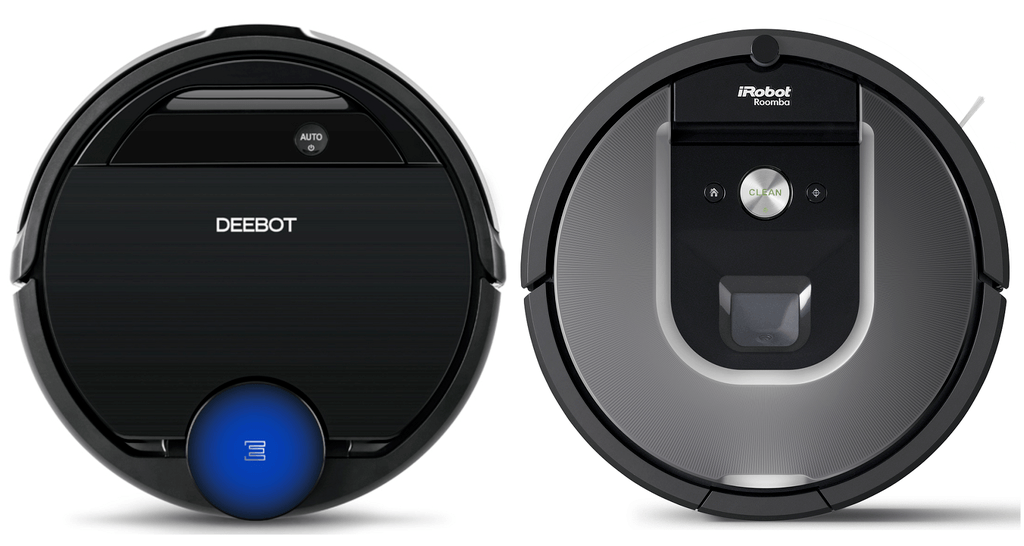In the latest Ecovacs release, the 2-in-1 mopping and vacuuming robot has some serious upgrades. This new technology adds to the price, but is it worth it?
We compare the Ecovacs Deebot Ozmo 960 and its new technology against an old favorite, the iRobot Roomba 960. Will the new technology make its stand or will the older tech stay steady and worthy? Read on to find out, the answer might just surprise you.
Contents
Differences between the Deebot 960 and the Roomba 960
The two 960 model robots have quite a few differences when you break it all down. Let’s look at those differences now.
- The most significant difference is that the Ecovacs Deebot has a water reservoir and will mop your hard flooring. The Roomba 960 doesn’t mop.
- Roomba uses camera-based iAdapt 2.0 navigation and mapping. The Ecovacs Deebot 960 uses laser-guided Smart Navi 3.0 (with AIVI) navigation and mapping.
- Camera-assist. Ecovacs introduces a new technology that uses a camera to “see” and avoid obstacles not on the map. Roomba doesn’t have this feature.
- Extraction methods. Deebot 960 has a single bristle brush roller for agitation and sweeping. The Roomba 960 uses the dual-brushless extractor rollers.
- Side brushes. Where Roomba only uses a single side brush, the Ecovacs model has two.
- Roomba uses the well-known dual-mode virtual wall containment method. Deebot has three containment methods, all of them are digital and found on the mobile app.
Similarities between the Deebot and Roomba
[easyazon_image align=”center” height=”375″ identifier=”B07ZTZ5LJH” locale=”US” src=”https://smartrobotichome.com/wp-content/uploads/2020/03/41dMVxONirL.jpg” tag=”srh-easyazon-20″ width=”500″]The rest of the robotic features are going to basically be the same or quite similar. They are both round and vacuum your carpets. Here are other features they have in common.
- The batteries are close in size, provide a similar runtime and will automatically be recharged as needed.
- Both robots use touch, drop and dirt detection sensors during their normal cleaning cycles.
- Wireless Controls. You will be able to use voice commands or mobile apps to control and interact with the Roomba 960 or Deboot 960.
- Rated floor types. Both robots are rated to clean all floor types, carpet, hardwood, laminate, vinyl, etc.
- Each model comes with a 1-year manufacturer’s warranty.
Specifications Chart
Now that we have a basic idea of how these two robots stand in regards to their similarities and differences, let’s see all of their stats and how they look on paper.
| Ecovac Deebot Ozmo 960 | Roomba 960 | |
| Size | 13.9×13.9×4.0 inches | 13.8×13.8×3.6 inches |
| Weight | 6.6 pounds | 8.7 pounds |
| Navigation | Smart Navi 3.0 with AIVI(TM) | iAdapt 2.0 |
| Battery | 3200mAH Lithium-ion | 3300mAh Lithium-ion |
| Runtime | Up to 110 minutes | Up to 120 minutes |
| Charge Time | About 3 hours | 3 hours |
| Automatic Recharge | Yes | Yes |
| Entire Level Clean | Yes | Yes |
| Filter | HEPA | High-efficiency |
| Carpet Boost | Yes | Yes |
| Drop Sensors | Yes | Yes |
| Bump Sensors | Yes | Yes |
| Dirt Detection Sensors | No | Yes |
| Camera Navigation | No | Yes |
| Laser Navigation | Yes | No |
| Camera Assist | Yes | No |
| Mopping | Yes | No |
| Water Reservoir Capacity | 250ml | N/A |
| Wireless Communications | Yes | Yes |
| Mobile App | Yes | Yes |
| Voice Controls | Yes | Yes |
| Floor Types | All | All (no high-pile carpeting) |
| Collection Bin Capacity | 0.47L | 0.5L |
| Side Brushes | 2 Side Brushes | 1 Side Brush |
| Containment | Digital Containment (Mobile App) | Dual Mode Virtual Wall Barrier |
| Warranty | 1 Year | 1 Year |
| Price | Check on Amazon | Check on Amazon |
Comparing the Deebot 960 to the Roomba 960
Now that we know how they look on paper, let’s see how they look doing what we pay for them to do.
Basic Features of Both Robots
All robotic vacuums use the same principles. Battery for power, a way to get around the home, and a method of collecting the dirt, dust and debris from your floors. These basic traits can make a huge difference in models, though, so it is important to discuss them.
The batteries of these two models are quite similar. The Ecovacs model has a 3200mAh battery that powers the robot for up to 110 minutes. It also runs all the processors and powers the wheels, motor and wireless signals.
Roomba’s 960 comes with a 3300mAh battery that runs the robot and all of its features for up to 120 minutes. The extra 10 minutes here is negligible and depending on your floor plan, layout and amount of furniture, you may find that these numbers change from time to time.
When the batteries get low, the two robots will return to the charging stations and recharge their batteries completely. If there is still cleaning left to do, after the recharge the 960’s will head back out and pick up where they left off.
Suction power is also the same. Both robots will produce about 1900pa of suction power for cleaning your hard flooring and carpeting. They also feature carpet boost technology. This means that when the robots are on carpeting, they will kick up the suction power to clean a little deeper.
Bottom Line: Both models have similar basic traits. In this comparison, the two robots start off with the same score, so this round is a tie.
The Roomba 960 used camera-based navigation that iRobot calls iAdapt 2.0. The robot still runs around primarily using the bump and touch sensors to determine where furniture and obstacles are. The camera is used to make the map that the robot uses to navigate the home as a whole.
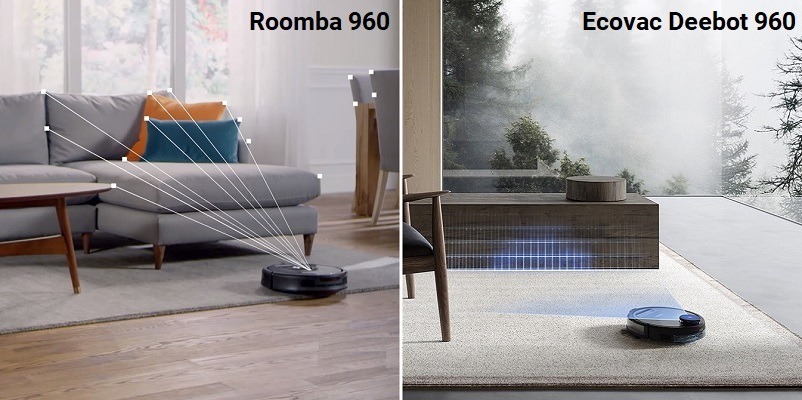
Ecovacs Deebot uses laser guided navigation. Instead of taking pictures to build the map, the robot uses a laser to scan the ceiling and look for doorways, windows, light fixtures and other landmarks. Once complete, the robot then uses bump and drop sensors to find the furniture and other obstacles as well. There is one new, glaring difference, though.
The Deebot 960 has a camera, too. The camera isn’t used for making maps, instead it is used to “see” what is in front of the robot so that it can avoid anything on your floor. Later in the “Real-World Expectations” section I will go into detail on how these navigation methods work with the cleaning abilities of the robots.
For now, what you need to know is that camera-based and laser-based navigation systems are used across the industry, and there isn’t one method that stands out as better than the other. The difference will come down to how that robot uses the technology.
Bottom Line: Both robots use different navigation systems, but they each produce an interactive map and navigate your home, so this round is also a tie.
Let’s Face it, You’re Here Because of the Poop
The marketing on the new camera feature of the Deebot 960 states that the 960 avoids “obstacles on the floor like socks.” Right. Socks. The first thing you thought was how there is now a robot that won’t try to clean and end up smearing poop left on the carpet by your dog.
The idea of a robot being able to notice new obstacles on the floor, such as poop, and then avoid them completely is a novel idea, and a much-needed one. Especially for those of us with pets that may not yet be house trained.
No more having to come home to smeared stains on the carpet with a hiding dog and a messy robot? Sign me up for that!
Bottom Line: The Ecovacs Deebot 960 wins this round. The ability to see items and avoid them if needed is a great piece of tech that the Roomba 960 doesn’t have.
Is Mopping Worth it?
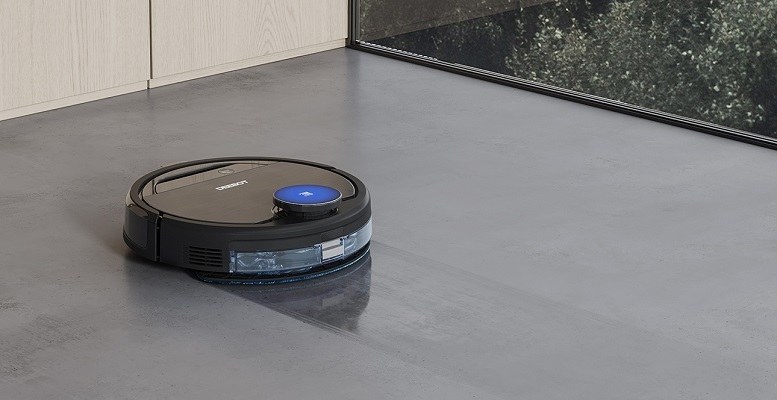
Since we have had robots cleaning our floors, companies have tried to create the best all-in-one robot that will sweep, vacuum and mop. The problem is, that to make the robots capable, there is a lot of technology that has to work together. Putting everything together without creating a 50 pound box is near impossible.
In every instance, the robots end up either mopping well, not vacuuming for much worth, or cleaning carpets incredibly well and can’t mop to save their price tag. A lot of times what turns out, though, is a robot that doesn’t do either well at all.
The Deebot 960 uses an OZMO water reservoir system. This means that is feeds the mopping pad as the robot moves around. It also enables the robot to do both, vacuum and mop, at the same time. The Deebot can sweep and vacuum up the debris on the hard flooring ahead of the mopping pad which will wash up behind.
The OZMO mopping system prevents you from having to run the robot in vacuum mode, then swap out all of the parts and run it again in mopping mode. The main problem with this type of system is that you can’t let the robot recharge while the water reservoir is in place or the mopping pad is wet.
While you can schedule a cleaning session that mops as well, even while you are away, you won’t want to. Coming home to a burned out robot, blown fuse or breaker, or worse, is not worth the risk.
Bottom Line: The Deebot 960 wins again. Because the Roomba doesn’t mop, it is an easy win category for the Ecovacs entrant.
Mobile Apps, The Battle Within the Battle
With wireless communications, you have the option to control the robots with voice commands or mobile apps. The voice controls are nice. With an Amazon Alexa or Google Assistant enabled device, you can start and stop cleaning sessions, create schedules and locate the robots if needed.
The main controls will come with the mobile apps. The iRobot Home app is by far the best on the market. With its intuitive interface, easy to set up menus and user-friendly menus and options, there isn’t anything better on the market.
With the Roomba 960, you won’t get as many options with voice controls or the mobile app as you do with the newer models. However, there is still plenty to do. With Alexa commands, there are over a dozen different voice controls to use.
See our review of the newer Roomba i7+ vs. S9+ here.
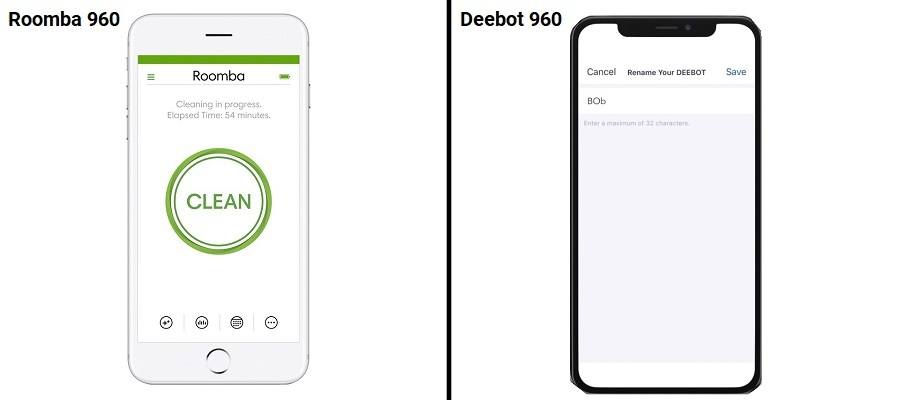
The mobile app is simple and controls every aspect of the robot, including the created map. The map doesn’t allow you to do much with it, but you can see the progress, what has and hasn’t been cleaned and see the runtime, battery level and battery usage during the cleaning cycle.
Ecovacs Takes it up a Notch
The Deebot 960 also has voice commands that work with Alexa and Google. It doesn’t have as many voice commands as the Roomba does, but you can ask Alexa where the robot is and it will tell you which room your robot is currently cleaning.
The ante is raised, though, with the mobile app. You get all the same controls and options as you do with the Roomba model, but you can also interact with the map. In fact, this is where you will use your containment options.
Deebot doesn’t have physical containment like the Roomba 960. The dual-mode virtual wall barriers of the Roomba line are still a favorite for their ease of use and reliability. However, what it has are three containment options through the mobile app.
First you can use no-go lines. These are lines or areas drawn with your finger on the map that the robot then pretends are walls. You can also draw areas for the robot to clean specifically. Similar to a spot clean, except these areas are the only ones cleaned.
Finally, you have the option to select specific rooms for cleaning, while avoiding others. With the three options, you would think the edge goes to the Deebot. But you’re wrong.
The Roomba containment works, and as I mentioned earlier, the mobile app is the best. Ecovacs has a way to go. The app is difficult to use. It works great when it works. You will spend more time trying to get the app to connect that you will using the robot.
When it connects, the digital containment is hit or miss, with a lot more miss than hit. And then, the app will stop responding, making you reinstall and start all over. I am confident that this will be fixed in the future, but for now, it makes owning the Deebot 960 more of a headache than a joy.
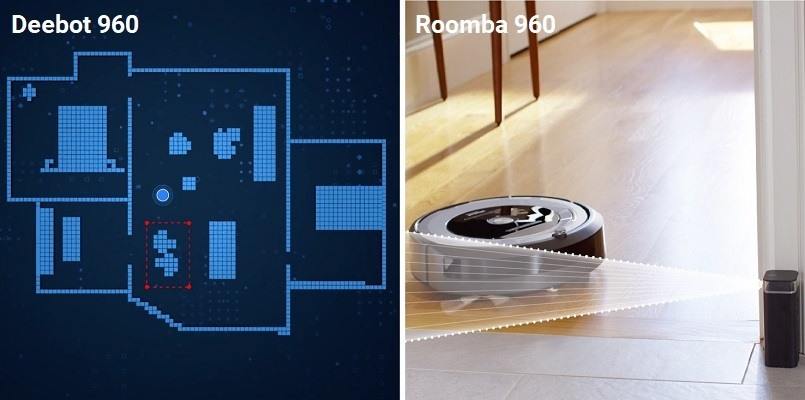
Bottom Line: This round goes to the Roomba 960, because everything works. The Deebot 960 will get better, but for now, loses this round.
Real-World Expectations
We have seen the promises and accolades. We’ve covered the specs and what the robots were designed to do. In your searches you have probably seen some testing videos. This section is none of those things.
I don’t have little 5-foot wooden boxes to toss some loose salt and cereal bits in to show you how the robot performs. I have a house. With things in it. And mixed flooring and furniture and shoes on the ground and a pile of dirty clothes. Real-world testing. It is what happens when you get the robot home and use it for yourself. So, let’s take a look at what happens with the two 960 models.
The Robots on Carpet
I won’t lie. The Roomba 900 series, specifically the 960 and 980 models, are hard to beat in cleaning carpet. Even the Roomba s9+, arguably the best robot on the planet right now, doesn’t outclass the 960 and 980 on carpeting by much.
The tangle-free dual rubber extractors are incredible at cleaning carpet. They agitate carpet fibers to loosen and lift debris from deep in the carpet pile. This includes all carpeting, even high-pile carpet. They rarely get stuck, either. If they do, the robot can free itself. When it comes to cleaning them, it takes less than a minute to remove, clean and put back to service.
The Deebot 960 doesn’t have rubber extractors. It uses a bristle brush roller that is removable. When it is installed it will agitate the carpet some, but anything beyond tight-woven medium pile carpet will be a no. It misses a lot of spots, too, which I will talk about more in the Obstacles section below. The carpet cleaning isn’t horrible, but it could be a lot better.
Cleaning the bristles is made easier with the cleaning tool, which is hidden away under the robot so it doesn’t get lost. The time it takes to clean, though, is still in the 5–10 minute range, so don’t expect a speedy maintenance routine.
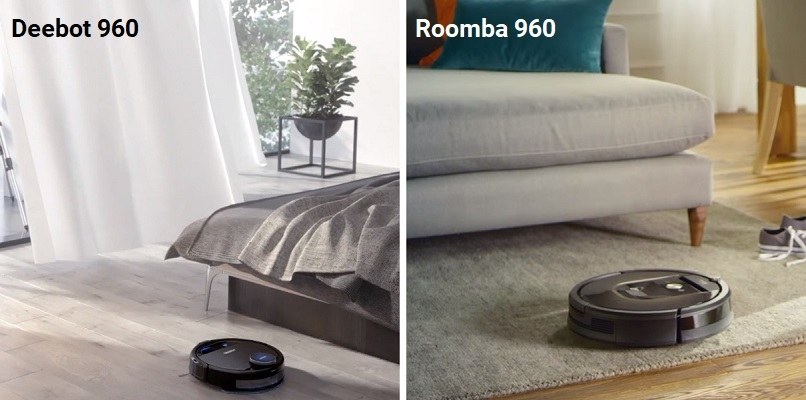
The Robots on Hard Floors
On hard flooring the two robots are pretty equal. The Roomba 960 kicks up a lot of lighter debris, especially when cleaning the edges. The exhaust air and high speed of the side brush look like it is making more of a mess than it cleans. It does clean everything eventually, though, it just looks bad in the process.
The Ecovacs Deebot 960 is much smoother on hard flooring. With the twin side brushes it can clean from any angle, which is nice. It has a little trouble getting into corners, but so does the Roomba model. The Deebot 960 doesn’t make a bigger mess before it cleans it up, but the results are about the same here.
The Robots Dealing with Obstacles
The biggest marketing of the Deebot 960 is that it avoids obstacles and with the camera to see things, it doesn’t run into anything, avoids “socks” on the ground and does a thorough cleaning of your home.
Until you get it home. The robot will avoid a sock. Most of the time. It doesn’t always work. Also, as far as avoiding other obstacles, it will ram into your furniture legs, walls and even your dog’s water bowl (of course it will then mop it up). When you look at the coverage map on the mobile app, you will also be slightly disappointed. There will be a lot of blue area left behind (blue is what hasn’t been cleaned, white areas are where it has cleaned).
The Ecovacs navigation wants to be the star of the circus, but ends up being more of the side show clown. On the other hand, the Roomba 960 doesn’t get everything either. Even with its parallel line, human-like cleaning patterns, it will miss a lot, especially around the edges of your rooms.
The Roomba model also doesn’t avoid obstacles. If it encounters one, it will try to move through it, if it cannot, then the robot moves around it. When it gets stuck on that sock the Deebot avoided, it will reverse the extractors, spit out the sock and keep going. When it comes to the dog poop, though… smear city.
Frequently Asked Questions
Now I will answer some of the more common questions about the two robot companies and their respective 960 models.
Q. What is the warranty like for the Roomba 960 and Deebot 960?
A. Both the Deebot and Roomba 960 models come with a 1-year warranty. These warranties cover the batteries, the robots and motors. The only things not covered are replaceable parts, such as the filters, side brushes and extractors.
Q. Where is the best place to buy these robots?
A. Both robots are sold through the manufacturer websites. However, the best place to purchase either robot right now is through Amazon. With faster shipping, better deals and specials, and easier customer service, going through the online retail giant is a smarter choice.
Q. What accessories will I need to buy in addition to the robots?
A. Both robots come with everything you need to get started. You can get the Roomba with or without the containment towers, and there are replenishment kits for the rollers, filters and side brushes, too. For the Ecovacs Deebot, you will get enough items to clean your home for several months. You will need more mopping pads and filters, but they sell kits for those as well.
Q. Where can I upload my cat riding Roomba videos?
A. Please don’t. While it is entertaining, a cat on your Roomba (or Deebot), will block the cameras and lasers and cause the robot to overheat, malfunction and you will end up with a paperweight that cost you several hundred dollars. Not a good idea, even for the 743 heart reactions and likes.
What I Like About the Roomba 960
- Best mobile app for controls in the industry.
- Reliable, time tested robot that works.
- Hair won’t get stuck on the rollers.
What I Like About the Deebot 960
- Doesn’t smear poop.
- Is quieter than most other robots.
- Super strong suction for a 3-in-1 robot.
Conclusion
The robot battles will rage on. As each company vies to create the ultimate floor cleaning assistant, there will most likely never be a clear winner. The best robot is the one that does the job you expect and has a price you can afford.
The Ecovacs Deebot OZMO 960 is arguably the best Deebot form the Ecovacs line. It has a little ways to go to be top-tier, even though it is already priced as such. With a faulty mobile app and an inability to manage containment correctly, there are tweaks to be made.
The Roomba 960, on the other hand, doesn’t boast about things it cannot do. With the release of newer robots, the price continues to fall as well, making it more and more ideal as your next robot vacuum. For me, if it came down to these two models, I would side with the less expensive Roomba 960. It is better on carpets and everything about it simply works. No tweaks needed.
